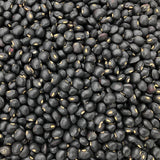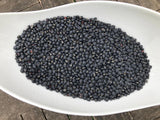Rouge et Noir Field Pea
Vigna unguiculata
A Southern pea aptly named "Red and Black" in French, this heirloom cowpea hails from Washington Parrish, Louisiana. Southern Exposure Seed Exchange writes that this variety has large seeds that are red when fresh and black when dried, and that it is similar to Peking Black, but produces earlier. William Woys Weaver notes that these peas are traditionally cooked with lima beans and green peanuts in Louisiana. Weaver himself describes them as long (about 10 ½ inches), shelly beans with up to 18 seeds per pod, a very productive, drought tolerant bush type that produces runners. In his book "100 Vegetables and Where They Come From," Weaver also notes that the fresh, young pods are lovely snap beans or as an accompanying ingredient in okra soup, and that they have commonly been toasted and mixed with roasted chicory root as a coffee substitute. These seeds have been grown from those which originally made their way to William Woys Weaver from the Lang family of Washington Parrish, LA, who kept up this variety for many years.
Days to maturity: 63
Seeds per pack: 50
Germination rate: 95% on 11/18/2024
Planting / harvesting notes
Direct sow black-eyed peas safely after frost, any time between late May and mid-July. This is a climbing vine crop, so it needs to be planted next to a structure or trellis. Plant 1" deep with 3-4" spacing, either in 1 row on each side of the net trellis or in another arrangement if using a different kind of trellis, like a pole or garden sculpture. Being a legume, it does fairly well in poor soils and adds nitrogen to improve them.
Seed keeping notes
Black-eyed peas are self-pollinating, though it is best to isolate different varieties of V. unguiculata (including black-eyed peas, southern peas, cowpeas, and long beans) at least 20 feet, if not much farther to avoid unwanted cross-pollination. Allow beans to dry fully into a brown crispy state. This is when they are ready to harvest for seed. If necessary, lay them out to dry a little longer in their pods.









